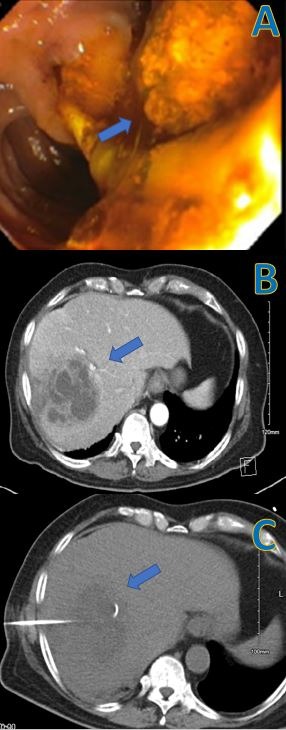Back
Poster Session E - Tuesday Afternoon
E0048 - A Unique Case of Endoscopic Retrograde Cholangiopancreatography Associated Eikenella corrodens Liver Abscess
Tuesday, October 25, 2022
3:00 PM – 5:00 PM ET
Location: Crown Ballroom

Ahmed M. Ahmed, DO
Rutgers New Jersey Medical School
Newark, NJ
Presenting Author(s)
Ahmed M. Ahmed, DO1, Yasir Rajwana, MD2, Youssef Botros, MD2
1Rutgers New Jersey Medical School, Newark, NJ; 2Jersey City Medical Center, Jersey City, NJ
Introduction: The most common complications of endoscopic retrograde cholangiopancreatography (ERCP) are pancreatitis, hemorrhage, cholangitis, and duodenal perforation. Rarely, septic complications of ERCP involve hepatic abscess, with the most common organisms being E. coli and P. aeruginosa. We present a unique case of ERCP related Eikenella liver abscess.
Case Description/Methods: 68-year-old male with a history of cholelithiasis and choledocholithiasis who underwent an ERCP with sphincterotomy, CBD stent placement and cholecystectomy 3 months ago, and poor dentition, presented with abdominal pain and fever. 1 month prior, he had an ERCP with common bile duct (CBD) stent removal and balloon sweep removal of a large amount of sludge and small stones. Since the procedure, he reported fatigue with 1 week of worsening right sided abdominal pain, nausea, and fever. He was found to be tachycardic and febrile to 102°F. Labs showed leukocytosis, transaminitis, and bilirubin of 2.6 mg/dL. An abdominal CT scan showed a rim enhancing, multiloculated lesion in the liver and CBD dilation and wall enhancement. He had a repeat ERCP for suspected cholangitis which again showed thick sludge and small stones on balloon sweep. He underwent placement of a 12F percutaneous catheter to drain the liver abscess whose cultures grew Eikenella Corrodens. His endocarditis workup was negative, and he completed a course of ceftriaxone for his infection with repeat CT showing improvement of the abscess.
Discussion: The literature is limited in cases of post ERCP hepatic abscess complications. Generally, bacteria can enter the biliary tract by a hematogenous or retrograde route which are normally protected by anatomical barriers. Obstructed and immunocompromised patients can be more susceptible to complications as they have impaired bacterial defenses. In this case, the patient was found to have E. corrodens, a common oral flora organism. Infectious work up was otherwise negative, including an endocarditis work up. It has been suspected that contamination from the mouth flora, given his poor dentition, ultimately led to device related introduction into the biliary tree and subsequent development of this rare ERCP related abscess. Adhering to endoscopic equipment disinfection protocols and proper ERCP technique for duct drainage is of utmost importance for minimizing the risk of infection. This case also highlights the justification for recent increase in the use of disposable duodenoscopes for ERCP to decrease infectious complications.

Disclosures:
Ahmed M. Ahmed, DO1, Yasir Rajwana, MD2, Youssef Botros, MD2. E0048 - A Unique Case of Endoscopic Retrograde Cholangiopancreatography Associated Eikenella corrodens Liver Abscess, ACG 2022 Annual Scientific Meeting Abstracts. Charlotte, NC: American College of Gastroenterology.
1Rutgers New Jersey Medical School, Newark, NJ; 2Jersey City Medical Center, Jersey City, NJ
Introduction: The most common complications of endoscopic retrograde cholangiopancreatography (ERCP) are pancreatitis, hemorrhage, cholangitis, and duodenal perforation. Rarely, septic complications of ERCP involve hepatic abscess, with the most common organisms being E. coli and P. aeruginosa. We present a unique case of ERCP related Eikenella liver abscess.
Case Description/Methods: 68-year-old male with a history of cholelithiasis and choledocholithiasis who underwent an ERCP with sphincterotomy, CBD stent placement and cholecystectomy 3 months ago, and poor dentition, presented with abdominal pain and fever. 1 month prior, he had an ERCP with common bile duct (CBD) stent removal and balloon sweep removal of a large amount of sludge and small stones. Since the procedure, he reported fatigue with 1 week of worsening right sided abdominal pain, nausea, and fever. He was found to be tachycardic and febrile to 102°F. Labs showed leukocytosis, transaminitis, and bilirubin of 2.6 mg/dL. An abdominal CT scan showed a rim enhancing, multiloculated lesion in the liver and CBD dilation and wall enhancement. He had a repeat ERCP for suspected cholangitis which again showed thick sludge and small stones on balloon sweep. He underwent placement of a 12F percutaneous catheter to drain the liver abscess whose cultures grew Eikenella Corrodens. His endocarditis workup was negative, and he completed a course of ceftriaxone for his infection with repeat CT showing improvement of the abscess.
Discussion: The literature is limited in cases of post ERCP hepatic abscess complications. Generally, bacteria can enter the biliary tract by a hematogenous or retrograde route which are normally protected by anatomical barriers. Obstructed and immunocompromised patients can be more susceptible to complications as they have impaired bacterial defenses. In this case, the patient was found to have E. corrodens, a common oral flora organism. Infectious work up was otherwise negative, including an endocarditis work up. It has been suspected that contamination from the mouth flora, given his poor dentition, ultimately led to device related introduction into the biliary tree and subsequent development of this rare ERCP related abscess. Adhering to endoscopic equipment disinfection protocols and proper ERCP technique for duct drainage is of utmost importance for minimizing the risk of infection. This case also highlights the justification for recent increase in the use of disposable duodenoscopes for ERCP to decrease infectious complications.

Figure: Image A demonstrates a large stone and sludge being removed during the patient’s ERCP procedure prior to developing the abscess. Image B demonstrates the CT finding of a liver abscess on presentation. Image C demonstrates improvement of the abscess post drainage from a percutaneous catheter.
Disclosures:
Ahmed Ahmed indicated no relevant financial relationships.
Yasir Rajwana indicated no relevant financial relationships.
Youssef Botros indicated no relevant financial relationships.
Ahmed M. Ahmed, DO1, Yasir Rajwana, MD2, Youssef Botros, MD2. E0048 - A Unique Case of Endoscopic Retrograde Cholangiopancreatography Associated Eikenella corrodens Liver Abscess, ACG 2022 Annual Scientific Meeting Abstracts. Charlotte, NC: American College of Gastroenterology.
